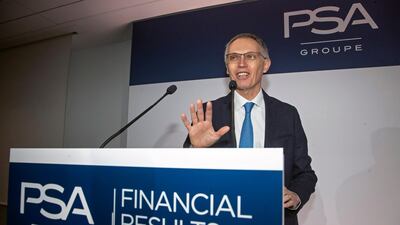While running Nissan’s North American operations from 2009 to 2011, Carlos Tavares had a reputation for closely watching costs with little tolerance for vehicles or ventures that didn’t make money.
Experts say that means Mr Tavares, currently the head of PSA Group, is likely to follow that blueprint when he becomes leader of a merged PSA and Fiat Chrysler Automobiles. The low-performing Chrysler brand might get the axe as could slow-selling cars, SUVs or trucks that lack potential.
Already the companies are talking about consolidating vehicle platforms – the underpinnings and powertrains – to save billions in engineering and manufacturing costs. That could mean job losses in Italy, Germany and Michigan as PSA Peugeot technology is integrated into North American and Italian vehicles.
“You can’t be cost efficient if you keep the entire scale of both companies,” said Karl Brauer, executive analyst for the iSeeCars.com auto website. “We’ve seen this show before, and we’re going to see it again where they economise these platforms across continents, across multiple markets.”
Shareholders of both companies are to meet on Monday to vote on the merger to form the world’s fourth-largest car maker, to be called Stellantis. The deal received EU regulatory approval just before Christmas.
Mr Tavares, who for years has wanted to sell PSA vehicles in the US, won’t take full control of the merged companies until the end of January at the earliest.
He is likely to target Europe for consolidation first, because that’s where Fiat vehicles overlap extensively with PSA’s, said IHS Markit's principal auto analyst Stephanie Brinley. Europe has been a money-loser for FCA, and factories in Italy are operating way below capacity – a concern for unions, given Fiat’s role as the largest private sector employer in the country.
“We are at a crossroads,’’ said Michele De Palma of the FIOM CGIL metalworkers’ union. “Either there is a relaunch, or there is a slow, agonising closure of industry, in particular the auto industry, in Italy.”
Italy’s hopes lie with the luxury Maserati and sporty Alfa Romeo brands, but Mr De Palma said investments are needed to bring hybrid and electric technology up to speed. Fiat’s Italian capacity stands at 1.5 million vehicles, but only a few hundred thousand are being produced each year. Most factories were on rolling short-term layoffs due to lack of demand even before the pandemic.
The merger is likely to also hit white collar workers, as Mr Tavares is unlikely to keep engineering centres in Paris, Turin and Rodelsheim, Germany, where the Opel brand he acquired in 2017 is located, according to analysts.
FCA’s North American operations, led by the popular Jeep brand and Ram pick-up trucks, are hugely profitable and are likely to be left untouched for a while, Ms Brinley said. Mr Tavares just three years ago stated his desire to sell PSA vehicles in the US within a decade. He said any global car maker has to sell in the US market.
In December, the companies announced that Fiat Chrysler chief executive Mike Manley would run Stellantis’ operations in the Americas.
Larger Jeep and Ram trucks and SUVs are unique to the US and generally don’t sell well in Europe, so Ms Brinley expects those to be designed by Fiat Chrysler in Auburn Hills, Michigan, north of Detroit. Eventually, some cars and some smaller SUVs, though, will move to PSA underpinnings, she said.
PSA has a wider array of fuel-efficient smaller engines, and Fiat Chrysler will need those to meet government fuel mileage and pollution requirements worldwide. The PSA Group’s goal is to offer its all models with electrified powertrains by 2025, an area where Fiat Chrysler also has lagged.
Analysts say the Chrysler brand could be in jeopardy in the US, where it has only two models, the ageing 300 saloon and the Pacifica minivan. US sales of the brand were off 19 per cent in the year to October.
The two companies have yet to announce any decisions on brands. Fiat Chrysler, in a statement from Michigan, said one of Stellantis's greatest strengths is its historic brands, including 10 from FCA, adding that there are no plans to close any plants. But PSA said in a statement from Paris that it hasn't announced any plans for the brands. “We will communicate in due course on this matter, as the EGA [shareholders' vote] is not the closing date, neither the announcement of a strategic plan,” the statement said.
Mr Brauer said US consumers aren’t likely to see Peugeot vehicles, though. Instead, smaller vehicles will be built on French or German underpinnings with bodies and interiors designed in Michigan.
While the tie-up is billed as a merger, the advantage goes to PSA, which will control six of the 11 board seats with Mr Tavares the tie-breaker.
Fiat Chrysler’s brands range from the powerhouse Jeep to the performance Abarth marquee and the historic Italian brand Lancia, which currently produces just one model, the Ypsilon, targetting female drivers. “I don’t expect cutting brands that still make volumes, even if they are focused on very specific market segments, like Lancia,” said Francesco Zirpoli, director for the Centre for Automotive and Mobility at Venice’s Ca’ Foscari University. But Stellantis will have too many factories in Europe making similar vehicles. “These overlaps have to be resolved,” he said.
Stellantis also will face a major challenge in Asia, in particular China, where both PSA and FCA are weak.
“The big market of the future is Asia. Asia will dominate the car business,’’ said Ferdinand Dudenhoeffer, of the Centre for Automotive Research in Germany. Already it is 45 per cent of global sales. “They merge, OK. They find synergies, OK. They reduce headcount, OK. But they are missing the most important point in the car business."

